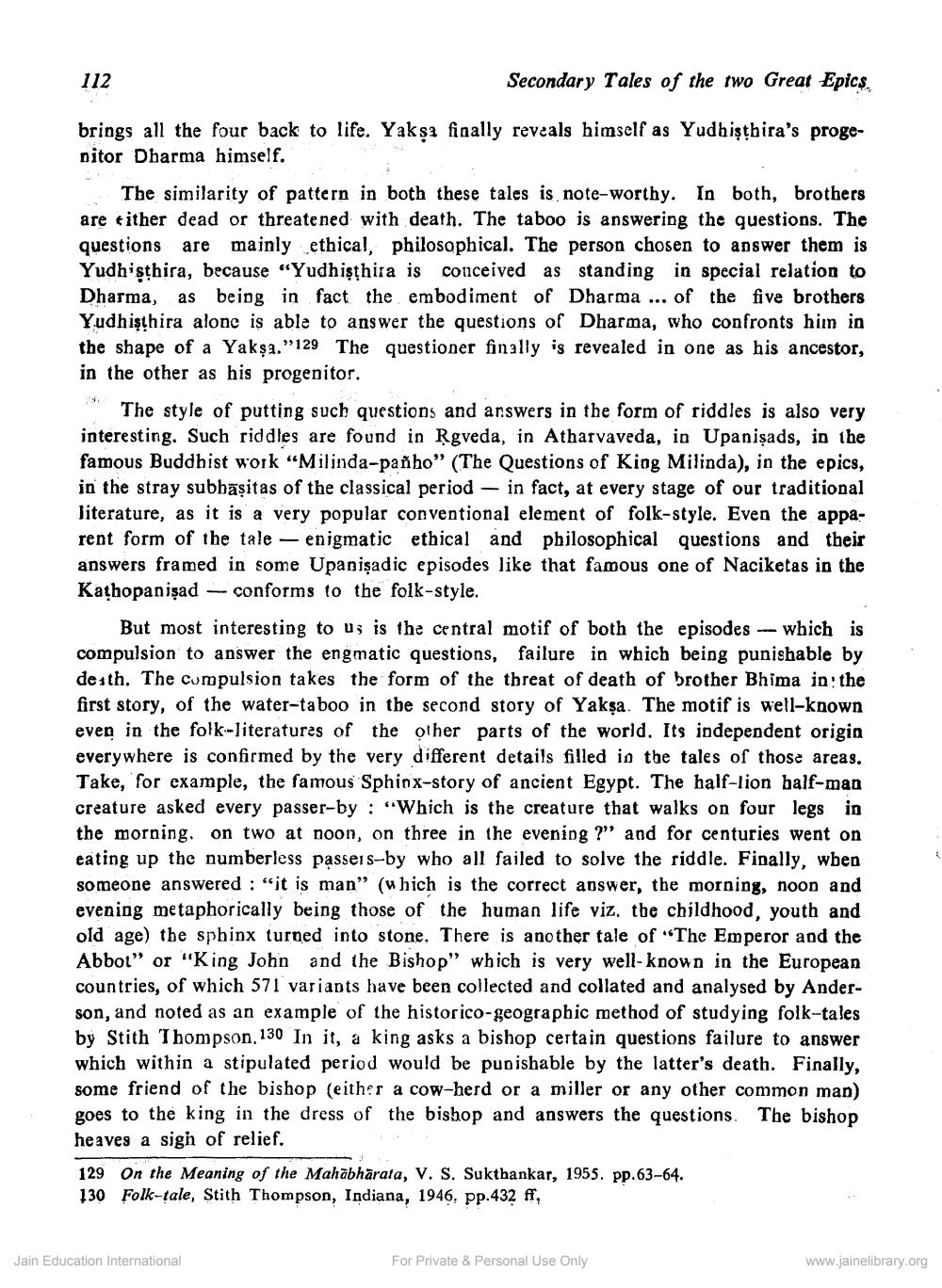________________
112
Secondary Tales of the two Great Epics.
brings all the four back to life. Yaks finally reveals himself as Yudhisthira's progepitor Dharma himself.
The similarity of pattern in both these tales is note-worthy. In both, brothers are either dead or threatened with death. The taboo is answering the questions. The questions are mainly ethical, philosophical. The person chosen to answer them is Yudhisthira, because “Yudhisthira is conceived as standing in special relation to Dharma, as being in fact the embodiment of Dharma ... of the five brothers Yudhişthira alone is able to answer the questions of Dharma, who confronts him in the shape of a Yakşa.”129 The questioner finally is revealed in one as his ancestor, in the other as his progenitor. ** The style of putting such questions and answers in the form of riddles is also very interesting. Such riddles are found in Rgveda, in Atharvaveda, in Upanişads, in the famous Buddhist work “Milinda-panho" (The Questions of King Milinda), in the epics, in the stray subhāṣitas of the classical period - in fact, at every stage of our traditional literature, as it is a very popular conventional element of folk-style. Even the apparent form of the tale - enigmatic ethical and philosophical questions and their answers framed in some Upanişadic episodes like that famous one of Naciketas in the Kathopanişad conforms to the folk-style.
But most interesting to u; is the central motif of both the episodes -- which is compulsion to answer the engmatic questions, failure in which being punishable by desth. The compulsion takes the form of the threat of death of brother Bhima in the first story, of the water-taboo in the second story of Yakşa. The motif is well-known even in the folk-literatures of the other parts of the world. Its independent origin everywhere is confirmed by the very different details filled in the tales of those areas. Take, for example, the famous Sphinx-story of ancient Egypt. The half-lion half-man creature asked every passer-by : "Which is the creature that walks on four legs in the morning. on two at noon, on three in the evening ?" and for centuries went on eating up the numberless passeis-by who all failed to solve the riddle. Finally, wben someone answered : “it is man" (which is the correct answer, the morning, noon and evening metaphorically being those of the human life viz, the childhood, youth and old age) the sphinx turned into stone. There is another tale of "The Emperor and the Abbot" or "King John and the Bishop" which is very well-known in the European countries, of which 571 variants have been collected and collated and analysed by Anderson, and noted as an example of the historico-geographic method of studying folk-tales by Stith 'Thompson, 130 In it, a king asks a bishop certain questions failure to answer which within a stipulated period would be punishable by the latter's death. Finally, some friend of the bishop (either a cow-herd or a miller or any other common man) goes to the king in the dress of the bishop and answers the questions. The bishop heaves a sign of relief. 129 On the Meaning of the Mahābhārata, V. S. Sukthankar, 1955. pp. 63-64. 130 Folk-tale, Stith Thompson, Indiana, 1946, pp.432 ff,
Jain Education International
For Private & Personal Use Only
www.jainelibrary.org




